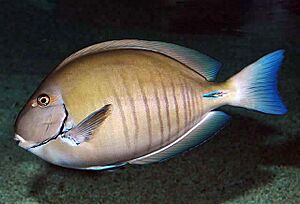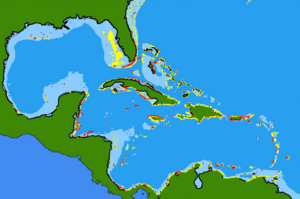Doctorfish tang facts for kids
Quick facts for kids Doctorfish tang |
|
|---|---|
 |
|
| Conservation status | |
| Scientific classification | |
 |
|
| Synonyms | |
|
The doctorfish tang (Acanthurus chirurgus), also known as the doctorfish, is a cool type of fish that lives in the ocean. It's part of a group called Acanthuridae, which includes surgeonfishes and tangs. You can find these fish mainly in the western Atlantic Ocean.
Contents
Meet the Doctorfish Tang
The doctorfish tang got its name because it has a special, sharp part on its tail. This part looks a bit like a surgeon's scalpel. It's used for protection and during fights with other fish. These fish are found in the warm waters of the Atlantic Ocean.
Why is it Called "Doctorfish"?
The name chirurgus means "surgeon" in Latin. This name was given because of the sharp, scalpel-like spines on the fish's tail. These spines are a key feature of all surgeonfishes. They help the fish defend itself from predators.
What Does a Doctorfish Look Like?
The doctorfish tang can grow up to about 39 centimeters (about 15 inches) long. It can weigh up to 5.1 kilograms (about 11 pounds).
- Color: Most doctorfish are blue-gray to dark brown.
- Stripes: They usually have 10 to 12 faint vertical stripes on their bodies.
- Fins: The edges of their tail, top, and bottom fins are often blue.
- Scalpel Ring: You might also see a faint blue ring around the "scalpel" on each side of its tail.
Sometimes, you might even spot a rare black doctorfish. This isn't a different type of fish, just a special color variation.
Where Do Doctorfish Live?
Doctorfish tangs love to live near rocky areas and coral reefs. They are found in the Atlantic Ocean, all the way from Massachusetts down to Brazil. They have also been seen near the west coast of Africa. Recently, a few have even been spotted in the central Mediterranean Sea.
How Do Doctorfish Behave?
Doctorfish are busy during the day. They spend their time grazing on algae and tiny bits of food from rocks. Their teeth are perfect for scraping off these plants.
- Digestion: Since they swallow their food whole, they have a special organ in their gut. It's like a gizzard and is filled with sand. This helps grind up their food before it's digested.
Baby Doctorfish
Doctorfish lay their eggs in groups, usually in the evening. Each egg is super tiny, less than a millimeter wide. They float in the water because they have a little bit of oil inside.
- Hatching: The baby fish, called larvae, hatch within a day. They are see-through and shaped like a diamond. They have big eyes and large fins.
- Growing Up: Many of their body parts, like scales and fins, grow later. The "scalpel" on their tail doesn't show up until they are about 13 millimeters long. As the "scalpel" grows, other spines shrink.
- Moving On: Once they are about 25 millimeters long, they move to the ocean bottom. They keep growing there and become adults in about nine months.


